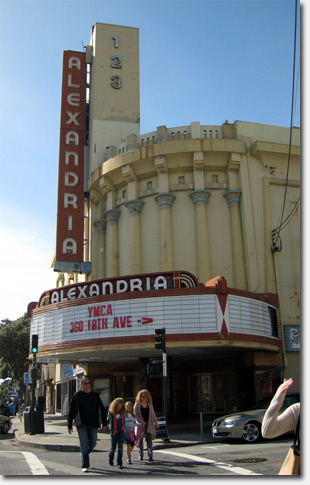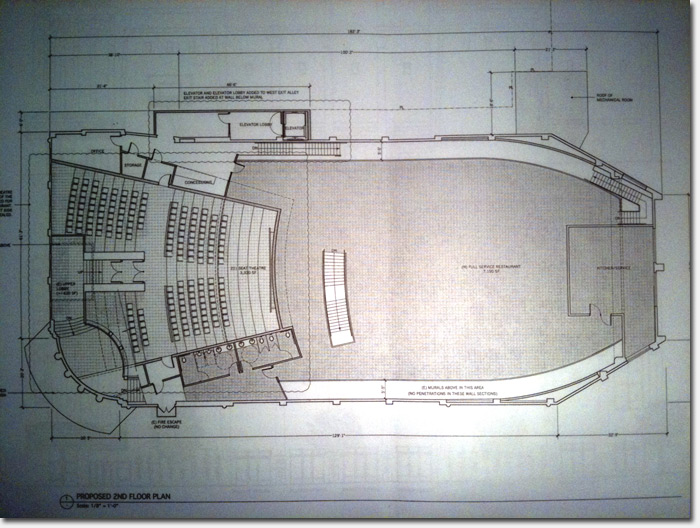Last Wednesday, the latest proposal for the Alexandria Theater building renovation was discussed by the Historic Preservation Commission, an arm of the Planning Department whose mission is to advise on projects related to landmark or historic properties in the city.
This 143 page Preliminary Mitigated Negative Declaration (PMND) was the main document up for discussion. You can listen to the audio from the January 19th hearing below:
[audio:https://richmondsfblog.com/dloads/2011Jan19_edit.mp3]Speaking on behalf of the Alexandria renovation project was Jonathan Pearlman, Design Principal at the architectural firm Elevation Partners. He told the commission he was called upon just a month ago to help the project sponsors rework the plans to better preserve some of the historic aspects of the original building such as art deco details of the architecture, wall murals and the domed ceiling. To accomodate this, the theater was moved to the south end of the building’s second floor and reduced in size slightly from 250 to 221 seats.
 Adjoining the theater on the second floor is commercial space which project sponsors are proposing be used for a restaurant. However Commissioner Hasz, himself a successful San Francisco restaurateur, felt there was flawed thinking in that.
Adjoining the theater on the second floor is commercial space which project sponsors are proposing be used for a restaurant. However Commissioner Hasz, himself a successful San Francisco restaurateur, felt there was flawed thinking in that.
“Something just seems odd here with the sponsor’s direction on putting a restaurant on the second floor – no windows, totally hidden. Whatever concept would have to go in there would have to be unbelievably particular and special,” Hasz said.
Pearlman pointed out that the restaurant would be marketed on the building’s exterior marquee and vertical blade sign, but Hasz remained unconvinced and questioned the project sponsor’s true intent for the space. “It feels like it’s gonna be turned into offices or something like that,” Hasz said.
This brought into question the overall plan for the second floor of the building, with commissioners questioning whether including a theater was a wise choice for the project. Pearlman said he was unsure if the project sponsors were originally required by the planning commission to include a theater.
Commissioner Buckley then replied, “It’s interesting that if the project sponsor doesn’t see the little theater as a prime economic engine then it seems to me it could be lost pretty easily and retain the entire volume upstairs.”
Commissioner Damkroger was open to the idea and said she’d like to see alternate plans where the upstairs was totally opened up, without a theater. “I think it would be worthwhile to pursue this to determine whether this is feasible,” she said.
During the discussion, Planning Department representative Tina Tam said that the department was in support of the current proposal, but could not comment on whether they’d support plans that did not include a theater.
If the entire second floor were commercial space with no theater, one does have to wonder what company would want to move in. “What kind of tenant would be able to move into such a large upper space if there was no theater? [This current mixed use proposal] seems like a reasonable compromise,” Commissioner Wolfram commented.
It’s unclear whether the project sponsor would move in this direction, especially since it would further delay the project as new plans would have to be reviewed and approved by the Planning Department.
And as one reader pointed out, it would be a shame if the second floor did turn out to be office space, since much of the historical details are on that level. They would largely go unappreciated by the general public when visiting the building.
Historically, the Alexandria has been a public gathering place for the neighborhood. How would you feel if it became just a building with a few shops, office space and condos on the back parking lot? Do you feel strongly about having a movie theater in the building?
The deadline for public comment on the Alexandria project is this Monday, January 24th. To send in your comments, contact Chelsea Fordham, Planning Department staff member at 575-9071 or at chelsea.fordham@sfgov.org.
Sarah B.

Architectural drawings of the 2nd floor where the theater and restaurant are located. Click to enlarge.
I take it windows are out because of the murals? That does limit what you can do with the space pretty severely. Even offices seem doubtful– who’d want an office with no windows? Maybe it could be some sort of auditorium/performance space, but if no one wants to pay for it…
It would be a shame if this died because no agreement could be reached. Ultimately it’s better to lose some history and have a place be used than it is to have it dead and sealed off in amber.
Hmm. It seems to me that somewhere along the line they lost focus of what they wanted to do here. Do they want a theater? Offices? Restaurant? The more I follow this, the more it feels like they’re having the same issue as the old boarded-up theater on the corner of Washington Square–all boarded up with a lot of talk, a lot of good ideas, but too many obstacles and misdirection that nothing’s getting done. They need to come up with a concrete plan and stick to it.
Lame. The whole point (for me, at least) to saving the Alexandria is to save the theater, not just the building/facade itself.
If the theater isn’t in the plans, figure out how to save the murals and other artwork, then take the building down or something.
I strongly support the inclusion of the theater to preserve the historical use of the building and to keep it a public gathering place. It would be a shame if this turned into another Walgreens or equivalent!
Agree with Rachel – if there isn’t a plan to keep the theater, remove any notable artwork and tear the building down in order to build something built specifically for retail/office/whatever.
If it can pencil out as a small theater, I’m for that.
@Chris, @Rachel: The building cannot be torn down. If you review the PMND or listen to the hearing, you’ll see that the Alexandria has been identified as a historic resource under CEQA and there are mitigation measures within the PMND which state the historic fabric of the building must be preserved pursuant to Secretary of the Interior Standards.
Thanks, Bob. I was lazy and didn’t read that.
Okay, then, so let’s try to find a good compromise for the theater. Maybe it could become a performing arts space that the YMCA and nearby schools could share, or something.